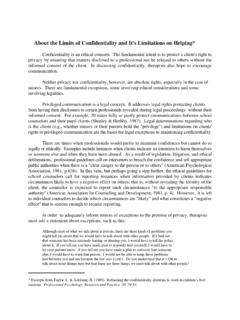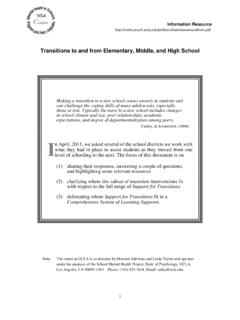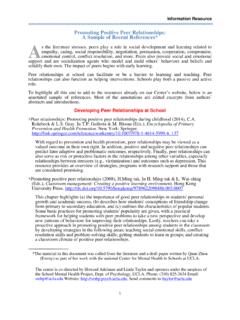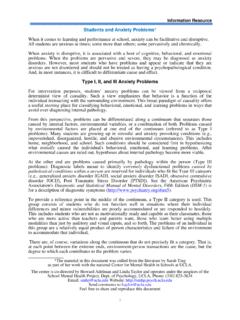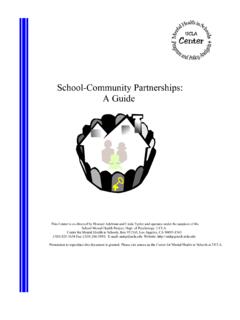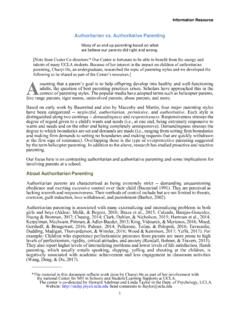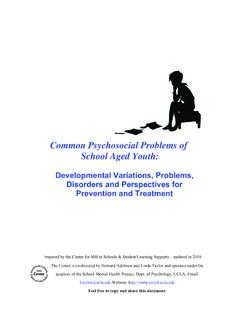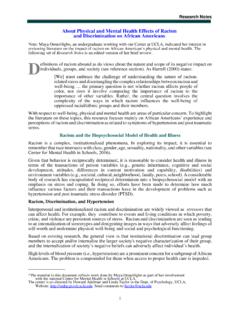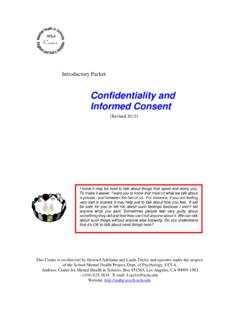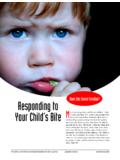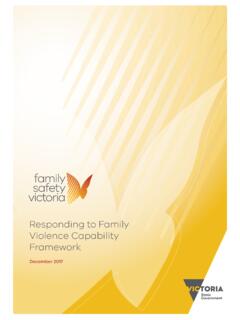Transcription of Responding to Crisis at a School
1 Resource AidResponding to Crisis at a School (Revised 2016)*The Center is co-directed by Howard Adelman and Linda Taylor and operates under the auspice of theSchool Mental Health Project, Dept. of Psychology, UCLA, Box 951563, Los Angeles, CA 90095-1563(310) 825-3634E-mail: Website: .Permission to reproduce this document is cite source as the Center for Mental Health in Schools at UCLA2I. School Based Crisis Intervention .. 4 Overview: Crisis Assistance and Should Be Responsible? ..15 About a School -Based Crisis Team ..16 Crisis Aftermath Subteams .. 20 Maintaining Crisis response Capability and School Awareness .. Basic Concerns for Effectively Responding to Crisis in Schools .. 22 Some Key Considerations in Establishing a System for School -Based Crisis Intervention .. 23 Major Facets of Crises Response .. 26 Responding to Crises: A Few General Principles .. 27 Crisis Response Checklist .. 28 School Crisis Guide .. 30 Example of One District's Crisis Checklist.
2 31 Helping Children Cope with Violence and Disasters .. 33 Guide for Developing High-Quality School Emergency Few Strategic Guides for Responding to Crisis ..37 Resources for Parents and .. 38 Psychological First Aid: Responding to a Student in Crisis .. 40 A Crisis Screening Interview .. 42 Informing the Student and Staff .. 45 Sample Letter to Send Home .. 46 Facilitating Class Discussion .. 47 Schools Helping Students Deal with 48 Dealing With The Media .. 54 District Policy Considerations .. 55 Responding to Crisis at a School and Training a School -Based Crisis Team .. 61 Building a School based Crisis Team ..62 Crisis Team Training ..66 Two Initial Training Sessions ..67V. Crisis Response and Prevention Intervention Outcomes Related to Six Major Facets of a Comprehensive Approach to Addressing Barriers to Learning .. 71 Presidential Policy Directive ..13 Planning for the Needs of Children in Specific Areas of Concern.
3 78 Natural Disasters .. 79 Community and Gang Violence .. 84 Suicidal Crisis .. 89 Family Violence .. 90 Sexual Assault .. 92 Grief and Loss .. 101 Hostage Situations .. 102 Post Traumatic Stress Disorder .. 103 Recommendations on the Support and Safety of Gay and Lesbian Students .. Online Clearinghouse QuickFinds ..112 , Organizations, Advocacy, Internet Sites & Hotlines .. Survey for Crisis Assistance and Prevention ..115X. Additional References on Responding to Crisis at a School .. 1214 Section ISchool-Based Crisis InterventionIn this section, you will find a brief, basic discussion of the need for a schoolto be able to plan and implement a response to crises. The material can beused to raise staff awareness of need and as shared reading prior to initiatingstaff : Crisis Assisance and Prevention Who Should Be Responsible?About a School -Based Crisis TeamCrisis Aftermath SubteamsMaintaining Crisis Response Capability and School AwarenessPresidential Policy Directive5 Crises Assistance and PreventionThere cannot be a Crisis next week.
4 My schedule is already KissingerCrisis, emergency, disaster, catastrophe, tragedy, trauma all are words heard frequently atschools today. Too many schools have had a major Crisis ; any School may have one soon. Besides natural disasters such as earthquakes, fires, and pandemic diseases, students experienceviolence and death related to suicide, gang activity, snipers, hostage-taking, and rape. Some studentsand staff react with severe emotional responses fear, grief, post traumatic stress syndrome. And,when a significant portion of a School s population is affected, major facets of a School 's functioningare jeopardized. When too little effort is made to intervene, the aftermath can interfere with schooland home performance, and long-term psychosocial and educational problems may intervention is for Responding to, minimizing the impact of, and preventing School andpersonal crises. After a Crisis , the first concern is to ensure physical safety and medical first aid; thisis followed immediately by attention to psychological considerations.
5 Then, the emphasis is on theschool s need to regain stability and a sense of normality so that students and staff can resumelearning and teaching. This includes attending to follow-up care as differ in the specificity with which they spell out procedures for schools to follow duringand in the aftermath of a Crisis . Based on district policy, schools plan for emergencies. It is rare,however, for districts to have addressed, in sufficient detail, policies and procedures for what to doin the days and weeks that follow a Crisis event and what to do to prevent future occurrences whenfeasible. Districts also differ in the amount of support they provide in helping schools establish and maintaincrisis response mechanisms ( , Crisis teams) and in training staff, as well as how much districtlevel staffing is available for Crisis intervention. Some, usually larger districts, may have regionalsupport Crisis teams that provide Crisis management, medical and psychological/counseling supportservices, media relations, and debriefing.
6 Others provide only an immediate response. The proper handling of School crises is essential to minimizing negative impact on learning andphysical and mental health. Comprehensive Crisis intervention planning and implementationprovides ways for School personnel, students, and families to return to normalcy as quickly asfeasible, address residual (longer-term) psychosocial problems, and explore preventive measures forthe of Crisis intervention include activity designed to minimize the personal and institutionalimpact of crises and establish a safe and productive School environment ( , that deters violence and reduces injury) emergency/ Crisis responses at a site collaboration with local schools ( , high School feeder pattern) and the community at-large for Crisis planning and response and to develop and implement strategies to enhancesafety and reduce violence, bullying, child abuse, suicide follow-up care when needed a violence prevention and resiliency curriculum designed to teach students angermanagement, problem-solving skills, social skills, and conflict AND DESIGNING CRISES ASSISTANCE AND PREVENTION Exhibit presents a prototype framework to help plan Crisis assistance and prevention.
7 (Go to theresources referenced at the end of this chapter for specific intervention ideas related to each of theseconcerns.)Exhibit Prototype Framework for Crises Assistance and Prevention *Major School -wide Crisis ( , major earthquake, fire in building, gun violence on campus)**Small group Crisis ( , in events where most students are unaffected such as a classmate'sdeath, the focus is on providing for specific classes, groups, and individuals who are upset)**Individual Crisis ( , student confides threat to hurt self or others such as suicide, assault)Several points should be highlighted related to the prototype framework. Clearly, the scope of theevent (major School -wide crises as contrasted to small group or individual crises) profoundly shapesthe number of responders needed during the various phases of the Crisis . Also, problems requiring attention during the Crisis are quite distinct from those arising in theimmediate aftermath and in the days and weeks following the event ( , hysteria and fear ascontrasted with grief reactions and post traumatic stress).
8 As with every intervention, multi-year strategic development requires gap analyses and prioritysetting and feasibility considerations. And, as with all student and learning supports, the work isstrengthened when a broad range of stakeholders and resources are coalesced to help with planningand implementation ( , students, staff, home, police, medical, and other community resources).Scope of EventMajor School -wide Crisis *Small GroupCrisis**IndividualCrisis**During the Emergency ImmediateAftermath Phases forwhich to planDays/WeeksFollowing Prevention inthe Future 7 WHAT ARE PRIORITIES IN ENHANCING CRISES ASSISTANCE AND PREVENTION?The prototype framework in Exhibit can guide gap analysis and setting priorities forintervention, personnel development, and ongoing support. For more specific examples to aid gapanalysis, see the self-study survey in Appendix C. The first priority is to upgrade Crisis intervention planning and response capability. This can bedone by a School 's administration or by establishing a standing Crisis response and preventionworkgroup.
9 In some districts, a School -based Crisis intervention team is delineated as the keyplanning and implementation mechanism. Planning groups vary in size; they benefit from theparticipation of an administrator, student support staff ( , nurse, psychologist, counselor), andanyone with special expertise from the district and tasks include reviewing strategic and action plans for Crisis response and prevention preparing all at a School for Responding to the different types of emergencies and makingspecific assignments and building capacity for crowd management, immediate medicaland psychological first aid, rumor control, and handling media preparing all at a School to implement recovery efforts so students can resume learningand staff can resume their duties and designing and building capacity for immediateaftermath counseling and debriefingAs the above basics are accomplished, the workgroup can enhance plans and capacity for providing brief and longer-term follow-up care as necessary preventing what is readily Reviewing Strategic and Action PlansEvery School needs Crisis assistance and prevention plans that establish specific responses anddelineate capacity building for implementation.
10 The focus in strategic and action planning is on suchmatters as: who will assume what roles and functions in Responding to a Crisis what types of events the School defines as a Crisis warranting a School -based response what defines a particular event as a Crisis how will different facets of Crisis response be handled (who, what, where) how to assess and triage medical and psychological trauma how to identify students and staff in need of aftermath intervention what types of responses will be made with respect to students, staff, parents, district,community, media what special provisions will be implemented to address language and culturalconsiderations which School personnel will make the responses how district and community resources will be used which personnel will review the adequacy of each response and make appropriaterevisions in crises response plans what in-service staff development and training are needed. how will everyone be informed about emergency and Crisis procedures8 Planning also addresses contingencies.
